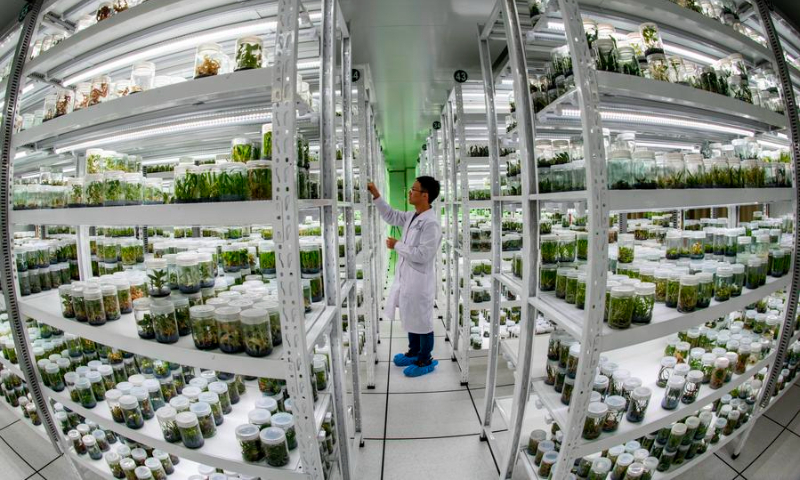
Photo taken on October 20, 2021, shows the vitro storage room at the Germplasm Bank of Wild Species in Kunming, Southwest China's Yunnan Province. Photo: Xinhua
China's new national crop germplasm resources bank has been established and become operational, with a preservation capacity of 1.5 million samples, capable of meeting the long-term strategic preservation needs for the next 50 years, China's Ministry of Agriculture and Rural Affairs (MOA) said on Tuesday.
Liu Lihua, an official from MOA, emphasized that China has built the world's largest, most advanced and well-managed germplasm resource conservation and utilization system. She made the remarks during a press conference on Tuesday when introducing the latest national agricultural germplasm resources census.
"About 63,000 samples of grain germplasms were newly collected, accounting for 45.4 percent of overall germplasms volume," Liu Xu, academician of the Chinese Academy of Engineering and leader of the third national crop germplasm resources census group, said on Tuesday at the press conference.
Four crops - rice, wheat, corn, and soybean - accounted for more than 30 percent of collected germplasm resources. Of these, soybeans make up the largest collection, with nearly 10,000 germplasm resources collected, reflecting the advantage that China enjoys from being an origin country of soybeans, he said.
Representing the new quality productive forces, China's biological breeding industry, as well as germplasm collection and protection, have been prioritized in recent years and have made concrete progress, Li Guoxiang, a researcher from the Rural Development Institute, Chinese Academy of Social Sciences, told the Global Times on Tuesday.
At present, more than 580,000 crop germplasm samples have been preserved for the long term, and the world's largest repository for poultry resources is expected to be completed by the end of 2026 with a maximum storage capacity of 33 million samples, said Liu Lihua.
In terms of aquatic resources, a world-class national marine fishery germplasm resource repository has been put into operation, with a preservation capacity of 350,000 samples. Meanwhile, a national agricultural microbial germplasm resource repository is being prepared, Liu Lihua said.
On February 21, 2021, China unveiled its "No. 1 central document" for the year, stressing that the protection, development and utilization of agricultural germplasm resources should be strengthened and the implementation of major scientific and technological projects in agricultural biological breeding should be accelerated, according to the Xinhua News Agency.
In July 2021, China issued an action plan to revitalize its seed industry through a technological self-reliance bid. Since then, the central government's No. 1 central document has emphasized accelerating the effort every year.
"Seeds and germplasms are the key to the nation's food security and are the basis for continuously cultivating varieties with high yield," said Li.
Since the No. 1 central document for 2021 was released, China has been enhancing its germplasm collection and protection, and taking measures in financial support, talent training and system building, Li noted.
The National Nanfan Research Institute of the Chinese Academy of Agricultural Sciences in Sanya, South China's Hainan Province, applies technological innovations into seed breeding, largely reducing the transformation period of scientific research results, according to Xinhua News Agency.
In Northeast China's Liaoning Province, a local cranberry grower in Fuyuan
sent 50,000 cranberry seeds into Earth's low-orbit onboard the Shenzhou-14 spacecraft for space breeding, in order to foster cranberry seed varieties with independent intellectual property rights by utilizing the special conditions available in space.




